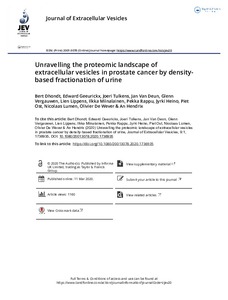Unravelling the proteomic landscape of extracellular vesicles in prostate cancer by density-based fractionation of urine
Heino J; Geeurickx E; De Wever O; Rappu P; Van Deun J; Hendrix A; Lippens L; Tulkens J; Miinalainen I; Ost P; Lumen N; Vergauwen G; Dhondt B
Unravelling the proteomic landscape of extracellular vesicles in prostate cancer by density-based fractionation of urine
Heino J
Geeurickx E
De Wever O
Rappu P
Van Deun J
Hendrix A
Lippens L
Tulkens J
Miinalainen I
Ost P
Lumen N
Vergauwen G
Dhondt B
TAYLOR & FRANCIS LTD
Julkaisun pysyvä osoite on:
https://urn.fi/URN:NBN:fi-fe2021042823204
https://urn.fi/URN:NBN:fi-fe2021042823204
Tiivistelmä
Extracellular vesicles (EV) are increasingly being recognized as important vehicles of intercellular communication and promising diagnostic and prognostic biomarkers in cancer. Despite this enormous clinical potential, the plethora of methods to separate EV from biofluids, providing material of highly variable purity, and lacking knowledge regarding methodological repeatability pose a barrier to clinical translation. Urine is considered an ideal proximal fluid for the study of EV in urological cancers due to its direct contact with the urogenital system. We demonstrate that density-based fractionation of urine by bottom-up Optiprep density gradient centrifugation separates EV and soluble proteins with high specificity and repeatability. Mass spectrometry-based proteomic analysis of urinary EV (uEV) in men with benign and malignant prostate disease allowed us to significantly expand the known human uEV proteome with high specificity and identifies a unique biological profile in prostate cancer not uncovered by the analysis of soluble proteins. In addition, profiling the proteome of EV separated from prostate tumour conditioned medium and matched uEV confirms the specificity of the identified uEV proteome for prostate cancer. Finally, a comparative proteomic analysis with uEV from patients with bladder and renal cancer provided additional evidence of the selective enrichment of protein signatures in uEV reflecting their respective cancer tissues of origin. In conclusion, this study identifies hundreds of previously undetected proteins in uEV of prostate cancer patients and provides a powerful toolbox to map uEV content and contaminants ultimately allowing biomarker discovery in urological cancers.
Kokoelmat
- Rinnakkaistallenteet [19250]
